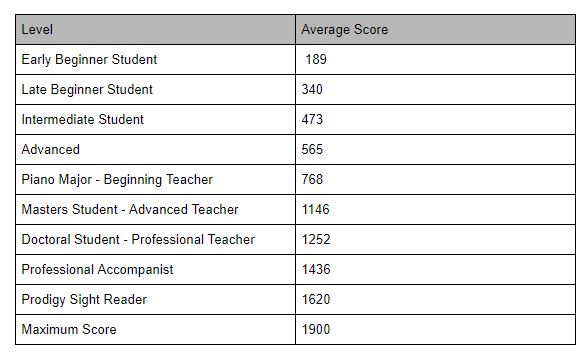Did you know that you can easily find out how well you can sight read right now? I have always wondered just how well I could sight read. Well, I just took a free, online 15 minute test that told me exactly how well I can sight read.
You can find out your piano sight reading level by taking the Standard Assessment of Sight Reading (SASR) Assessment. It is a standardized test, created by 165 collaborators that has now been adopted as the standard assessment for all piano sight readers. The test is available for free, it takes less than 15 minutes, and it gives you instant results.
I took the assessment myself and I learned a lot about just where my piano sight reading level is right now.

Piano Sight Reading Levels
When you take the sight reading assessment, you will find be given a score based on your performance within the assessment tool. Here is a chart showing the levels in comparison with the average score for that level.

Your sight reading level is determined at the conclusion of the test. You will know immediately where you score.
Piano Marvel explains that the more you take the test, the better your score will be. So even if you get a sight reading score you aren’t proud of, keep working at it and you can increase your score, and your level of sight reading expertise.
Taking the Standard Assessment of Sight Reading Assessment (SASR)
I had just barely found out about this sight reading test when I decided to jump in and do it. I have always been a little curious about where I am at with this. I do with I had gone in a little more prepared, but it’s not like I can’t take it again.
Here’s what to expect. The test took me about 15 minutes or less. You will need to be hooked up to your keyboard with a midi hookup. Create a free Piano Marvel account. The assessment is part of their program, but don’t worry, you can do it for free without any strings attached. Although, as a plug for Piano Marvel, I do think it is an awesome resource as I have played around with it. The more I play around with it, the more I am amazed at what’s there. It isn’t exactly as user friendly as I would like, but don’t let that scare you away.
Once you have an account, click on the SASR from the top of the screen. It will take you straight to the test.
The assessment will ask you what level you want to start with. Pick a level you know you are pretty comfortable with. I chose intermediate just because I felt pretty confident I could ace that part of it. Just pick a level that is a little lower than you would think you are, because it starts easier and progressively gets more difficult as you are assessed.
You will be given a piece to sight read. You have 20 seconds to look over the piece. In that 20 seconds, familiarize yourself with the song. Check the time and key signature, look for any rhythmic patterns, any accidentals, or anything in the music you should take note of.
You will hear a voice that gives you a countdown beat, and then you begin. You will try and play right on beat with the music you hear. It seemed that they had some sort of backtrack, or even the actual music in the background. Honestly, I was concentrating on playing so I didn’t exactly catch what it was every time. But I appreciated the backtrack because it helped me to stay on beat with the computer, which helps to improve your assessment score.
After you play that song, you will be given a percentage score. You can then look over the piece and see where, or if, you got things wrong. They are looking for timing and accuracy. A red note will represent a mistake, a green note shows that it is correct. I enjoyed looking over the piece to see exactly where I got wrong.
If you get an 80% or above, you are give a new, slightly more difficult piece of music to sight read. You are give a score right away. This score either improves or drops according to how well you continue to sight read.
If you do not score an 80%, you are given a strike. Three strikes and the assessment is over. If you get below an 80%, then you will be given a slightly less difficult piece to sight read.
The songs you sight read are about 4 lines long, so not very long.
Challenges to Determining Your Sight Reading Level
I thought the SASR through Piano Marvel was pretty cool. I was pretty excited to get a score just like that after a few minutes of sight reading. I did think there were a couple challenges that were not necessarily my fault, and may not exactly represent my sight reading level well. But this is always the case when it comes to standardized tests.
For instance, in this test, I may have gotten behind by a fraction of a second, and if I didn’t “catch up” to the music, then it would show that I had done a terrible sight reading on that piece, when in reality, I nailed it, except that I got off by a beat or two at the beginning.
Fortunately, the backtrack that goes with the music helps you to stay on beat and “catch up” to where you need to be. Unfortunately, the backtrack also distracted me at times. Sight reading has a great deal to do with listening to yourself and immediately being able to identify timing and notes correctly.
As I was seeking to tune into the music, having the backtrack threw me off at times because it wasn’t what it should have been sounding like because it wasn’t the written music. I do feel like you can overcome this without it being too big of a deal, but I wish I had been better prepared in realizing what was happening and planning for that to occur.
Piano Marvel does specify that the more you take the assessment, the better you become. Practice makes perfect, right? I do feel like this can become the case. I see this as a great tool for helping to improve your sight reading.
But I do also see slight flaw in the system. It could just be the “teacher” side of me here, but I see it as, you may not exactly be improving your sight reading as much as you are just getting better at taking the test. I guess it’s just something to be aware of and something you may have to just come to terms with. The test just may not be really showing your sight reading level accurately, purely because you may just be bad at taking this kind of test.
There is quite a bit of pressure that comes with staying up to speed. While this is accurate to an orchestra or band, a piano player often has some flexibility in timing that is not allowed in this test. So that pressure of staying right on top of the beat can cause undo stress that my affect your performance as well. It isn’t hard to get your heart pumping as you seek to concentrate and stay exactly on top of that beat to get a great score.
Improving Your Sight Reading Skills
Anything can get better with a little bit of work and effort. The same goes with improving your sight reading skills! You can get there, and it actually isn’t too hard to do so.
Piano Marvel suggests taking the sight reading assessment once a day for up to a month. It has shown a 45 point increase in just 28 days when people do that! You can also try practicing the other repertoire, methods, and technique courses that Piano Marvel offers. There is quite a bit available with their free account.
You may just need the practice of a steady beat (using a metronome or the program’s back tracks), playing with a computer, and reading music off of a computer to help you improve your score. These are actually pretty simple steps that could really help you to improve if it is at all an issue for you.
Outside of Piano Marvel, you can practice looking at music and singing it in your head if you can. Imagining where your hands would be placed and what they would be doing. In fact, studies have shown that when your brain is thinking about doing something, it is not unlike actually doing the activity itself. (See Science Direct: Mental practice)
It is totally possible to improve your sight reading skills and you can do it! Go take the assessment today at Piano Marvel and see where you are at today!
If you are still reading the article, then I thought I would tell you where I ended up on the first time I have ever taken this assessment. It’s not my favorite score, but one that I can stand by for now! I actually believe I could turn around and take it again and up myself at least a level. For right now, my SASR level is between advanced and a piano major – beginning teacher. I got a 648 my first time taking this assessment. Not bad, but I know I can do better!
As an update, after writing this article, I took the SASR a few days later, and guess what? I improved my score significantly. I got an 840 (well into a Piano Major – Beginner Teacher but a little ways to go for a Masters Student – Advanced Teacher) my second time taking the test. Goes to show that it does become easier. You are getting better the more you practice and take the test.
Related Articles
How to Improve Your Piano Skills
Tel loves her life as a piano player, a piano teacher, and a mom. Amid piano blogging, piano teaching, and piano playing, she loves a chance to fit in a good exercise class, volunteer at her kids’ school and at her church, and go on long dates with her husband. Full bio at About Tel.


